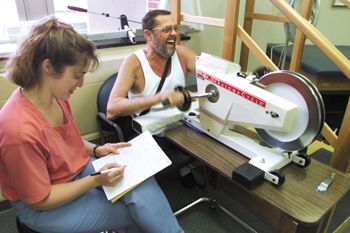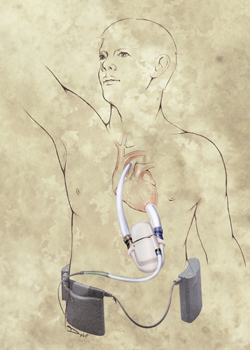
LVAD recipient Cyril Riley works with Michelle Spradley, an occupational therapist. (photo by Anne Rayner)
LVAD procedure promises new hope

An illustration of the LVAD device similar to the one implanted in Riley. (illustration by Dominic Doyle)
Spend time with Cyril Riley and soon you’ll be tapping your foot to the beat – he does.
The rhythm is not coming from a radio or some tune he’s humming. It’s the loud, hollow sound of Riley’s LVAD pumping blood through his heart. The opening and closing of the mechanical plates that push blood through the device, perhaps a distraction to most, brings a smile to Riley’s face – it’s music to his ears.
On June 19, Riley became Vanderbilt’s first patient to receive a Left Ventricular Assist Device (LVAD) as a destination therapy. Traditionally, this device is used for patients as a bridge to heart transplant. The implantable circulatory support system, a mechanical device that pumps blood through the heart, is used in cardiac transplant patients at risk of imminent death from left ventricular failure.
Now, the device is under study as a destination therapy for patients who are not transplant candidates. The Intrepid Trial is a study using the Novacor system to explore how long the device can be safely used. Vanderbilt is one of five sites approved for the study.
The Medical Center will enroll five patients in the pilot phase with plans to increase the number of patients to at least 20.
Statistics for long-term survival includes 60 patients who have been successfully supported with this LVAD device for more than one year and 30 for more than two years. Bench tests suggest that the device may need to be replaced after four years.
“I don’t know how long it will last,” said Riley, who is from the Chattanooga area. “I’m just glad I have it.”
“I feel great,” Riley said, just two weeks after the device was implanted. “It’s amazing. Before getting this device, I couldn’t go to my own kitchen and peel potatoes. I would sit in my recliner all day.”
For more than a year, Riley has been confined to his home unable to do the things he loved most – garden, cook and most importantly interact with his children, ages 13, 14 and 16.
“My 14-year-old would come up to me and ask when would we get to go four-wheeling or hunting,” Riley said. “To say that I couldn’t really hurt. “He’d ask ‘then could you play catch with me?’ It’s awful not being able to play with your children and sit and watch everything happen around you.”
When doctors told Riley about the trial, he said there were not many options to weigh. Without medical intervention, he was given six months to a year to live. Cardiomyopathy or heart muscle disease and an enlarged heart are the causes of Riley’s medical problems. He was not a transplant candidate because of severe lung disease caused by smoking.
“I just said the good Lord is going to take care of me and I was not worried,” he said.
Now the energetic Riley, 64, is ready to enjoy his life, something that both doctors and his family are very pleased by.
Dr. John R. Wilson, professor of Medicine, has been treating Riley for five years and has watched his patient’s failing health.
“About a month ago we found that he had very low cardiac output failure,” Wilson said. “That means he had no ability to pump extra blood during any level of activity. Even minimal exertion made him exhausted. He was completely debilitated.
“But since he has received the device, within one day he was feeling better and within two days he was walking around. We are very, very pleased.”
This use of an LVAD is a new indication for this device that was previously used only for temporary support of the heart until a donor heart became available for transplant. Ultimately, doctors see this device as a tangible alternative to transplant, which may serve as a permanent therapy for some. Now, patients who previously had no options have a chance.
Dr. Richard Norris Pierson III, associate professor of Cardiac and Thoracic Surgery, is the principal investigator for Vanderbilt’s trial.
“The use of this device could have a substantial impact on the quality of life and the costs of cardiac health care,” Pierson said. “The system is very reliable and easy to troubleshoot. The LVAD is less expensive than treating chronic heart failure and its management and costs are less than a transplant.
“We are hoping that the machine will prove to be a lifesaving measure for the majority of people with end-stage heart failure who are not transplant candidates.”
But doctors warn that this device is not a cure-all.
“This is still considered a halfway technology,” said Dr. Stacy Davis, assistant professor of Medicine and medical director of the Vanderbilt Heart Transplant Program. “This treats the consequence of the disease, but does not get to the root causes. The device can improve a patient’s lifestyle and quality of life.”
Although the LVAD is viewed as a promising therapy for heart failure patients, it also brings potential challenges including strokes, caused by blood clots, infection from the device’s power cable that is implanted under the skin, and the inconvenience of carrying around a 15-pound device.
Despite some of the pitfalls, the device brings many opportunities for patients as well as for the medical professionals seeking to use these devices to improve patient’s lives.
“We will learn more about how people do with these devices and take that information and not only improve the device itself, but ultimately improve patient care,” Davis said.
It’s a goal Riley shares also.
“If by doing this I can improve one or even two other people’s lives, I did my job,” Riley said. “I have opened doors for other people and I feel 100 percent better just about that.”
Riley’s wife, Mary couldn’t be happier about the changes in her husband since having the device implanted.
“It’s a new beginning for us,” she said. “I’ve got him back. He’s been down for so long, it’s amazing to see him this way. We can just pick up and go now. The first time we walked together when he was on the battery pack, he was in front of me. I’m usually in front of him waiting. But not anymore.”
Once the LVAD is implanted, patients not only return to Vanderbilt for physician follow-up care, but also equipment checkups. Rick Scott, Biomedical supervisor and LVAS (left ventricular assist systems) senior operator at Vanderbilt handles the programming for each device, the maintenance, and assists with the implantation.













